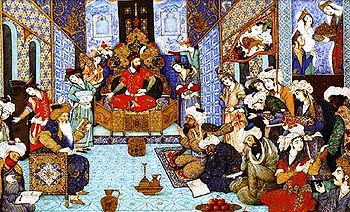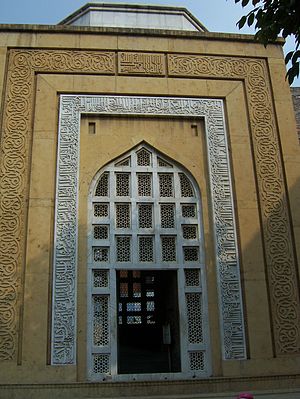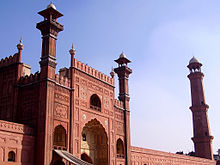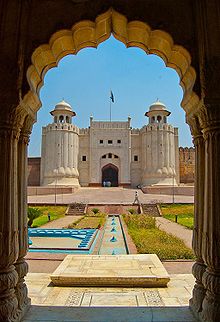- History of Lahore
-
The recorded history of Lahore (Urdu: تاريخ لاہور), a city-district of modern-day Pakistan, covers thousands of years. Originally the capital and largest city of the Punjab region, it has since its creation changed hands from Hindu, Greek, Afghan, Muslim, Sikh and British rule to becoming the cultural capital and the heart of modern day Pakistan.
Contents
Origins
Main articles: Origins of Lahore and Etymology of LahoreA mythological legend, based on oral traditions, states that Lahore was named after Lava, son of the Hindu god Rama, who supposedly founded the city. To this day, the Lahore Fort has a vacant temple dedicated to Lava (also pronounced Loh, hence "Loh-awar" or The Fort of Loh). Likewise, the Ravi River that flows through northern Lahore was named for the Hindu goddess Durga.[1]
Ptolemy, the celebrated astronomer and geographer, mentions in his Geographia a city called Labokla[2] situated on the route between the Indus River and Palibothra, or Pataliputra (Patna), in a tract of country called Kasperia (Kashmir), described as extending along the rivers Bidastes or Vitasta (Jhelum), Sandabal or Chandra Bhaga (Chenab), and Adris or Iravati (Ravi).
The oldest authentic document about Lahore was written anonymously in 982 and is called Hudud-i-Alam.[3] It was translated into English by Vladimir Fedorovich Minorsky and published in Lahore in 1927. In this document, Lahore is referred to as a small shahr (city) with "impressive temples, large markets and huge orchards." It refers to "two major markets around which dwellings exist," and it also mentions "the mud walls that enclose these two dwellings to make it one." The original document is currently held in the British Museum.[4]
Hindu heritage
The city of Lahore has a Rajput origin. The earliest princes were said to be Rajputs and traditional panjabi tribal origins. Hieun Tsang, the Chinese traveller, who visited the Punjab in 630 AD, speaks of a large city, containing many thousands of families, chiefly Brahmans, situated on the eastern frontier of the kingdom of Cheka, which he says, extended from the Indus to the Beas river.
Around 580 BC., when king Bimbisara ruled South Asia, the society came to be divided into different communities based on their occupation.[dubious ][citation needed] One of their communities was called Kshatriyas and King Luv's descendants were classed with them and came to be known as Luvanam, which was also referred to as Luvana.[1] The Luvanas from Loharghat became known as Loharana (masters of swords;[dubious ][citation needed] or iron ("Loha") chiefs ("Rana")), which later became Lohana.[dubious ]
Chinese traveller Fa-hien, who visited South Asia between 414 and 399 B.C., calls Lohana a brave community ruling the northwest territory of South Asia, in his diary.[citation needed] Another Chinese traveler, Kurmang who came in the eleventh century A.D. speaks of a Lohrana kingdom as a mighty power.[citation needed][dubious ] Historian Burton writes Lohanas were brave people and says they were spread over today's Baluchistan (Pakistan), Afghanistan and eastern fringes of Central Asia.[citation needed] Col. Todd, who delved into history of Rajasthan, describes Lohanas as one of the oldest Kshatriya community
The old Hindu city
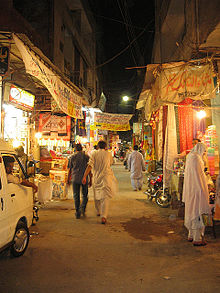 Present view of the Ichhra Bazaar (Market) at night. The market, because of being designed in very old style is very narrow for vehicles to cross and shoppers to walk.
Present view of the Ichhra Bazaar (Market) at night. The market, because of being designed in very old style is very narrow for vehicles to cross and shoppers to walk.
Many historians agree that Lahore was founded by an ancient Rajput colony sometime between the first and seventh centuries, probably as early as the beginning of the second; that it soon rose to be a place of importance, the parent of other colonies, and eventually the capital of a powerful principality, to which it gave its name. There are some grounds supporting that the old Hindu city of Lahore did not occupy exactly the site of the modern city. Tradition points the site of old Lahore to the vicinity of Ichhra - which is now a part of Lahore city - but was back then a village about three miles to the west.
The name of the village was formerly Icchra Lahore . Moreover, some of the oldest and most sacred Hindu shrines are found within this locality, namely Bhairo ka sthain and the Chandrat. The gate of the present city, known as the Lahori or Lohari Gate was so called as being the gateway looking in the direction of Lohawar or old Lahore just as the Kashmiri Gate looks towards Kashmir, and the Delhi Gate of modern Delhi to the ancient city of that name.[5]
There are no architectural remains of the old Hindu city of Lahore, a circumstance which might well be explained by the absence of stone material, and the numerous destructive invasions to which the city has been subjected. But also, in accordance with what all Indian architectural researchers tend to show namely, that the northern Hindus were not, until a comparatively late period, in the habit of building temples, or durable edifices of any kind. Even at Delhi, the seat of Hindu dynasties from upwards of a thousand years before CE to more than a thousand years after CE, and there, where is abundance of stone, no specimens of Hindu architecture exist dating earlier than the tenth or eleventh century.[6]
Early Muslim dynasties
Further information: Delhi SultanateAt the period of the first Muslim conquests, Lahore was in possession of a Chauhan prince, of the family of Ajmer. Whether owing to change of dynasty, or to Lahore's exposed position on the high road from Afghanistan to India, it was subsequently deserted and the seat of the government was removed to Sialkot or its vicinity, where it remained until the period of the conquests of Sultan Mahmud Ghaznavi in the beginning of the eleventh century; that the conqueror re-occupied the deserted city, and established a garrison in a fort, which was built possibly, like the Old Fort at Delhi, on the ruin of the old Rajput stronghold.
In 682 AD, according to Ferishta, the Afghans of Kerman and Peshawar, who had, even at that early period, embraced the Islam, wrested certain possessions from the Hindu prince. A war ensued, and in the space seventy battles were fought with varied success, until the Afghans, having formed an alliance with the Ghakkars, a wild tribe inhabiting the Salt Range of Punjab, compelled the Raja to cede a portion of his territory. The next mention of Lahore is in the Rajputana chronicles, where the Bussas of Lahore, a Rajput tribe, are mentioned as rallying to the defence of Chittore, when besieged by Muslim forces in the beginning of the ninth century.
Image of Sultan Mahmud Ghaznavi in his court where noblemen and noblewomen convened.
At length, in 975 AD, Sultan Sabuktigin, Governor of Khorassan and father of the celebrated Sultan Mahmud Ghaznavi advanced beyond the Indus. He was met by Raja Jayapala, the Raja of Lahore whose dominion is said to have extended from Sirhind to Laghman and from Kashmir to Multan. By the advise of the Bhati tribe, the Raja Jayapala formed an alliance with the Afghans, and, with their aid, was enabled to withstand the first invasion. However, Sabuktigin later repeated his conquest on his succession to the throne of Ghazni. A battle ensued in the vicinity of Lamghan ending with the defeat of the Raja and overtures being made for peace. His terms were accepted and persons were sent, on the part of Sabuktigin, to take the balance of the stipulated ransom. On reaching Lahore, Jayapala proved faithless and imprisoned those commissioned to receive the treasure. On learning intelligence of his perfidy, Sabuktigin, in the words of the Ferishta, "like a foaming torrent, hastened towards Hindustan".[7]
Another battles ensued, in which Jaipal was again vanquished, and he retreated, leaving the territory to the west of the Nilab or Indus in the hands of the invader. The invader did not retain the conquests that he had made for in 1008 AD, a confederation headed by Anandapala, the son of Raja Jayapala, again met the advancing army, now commanded by Mahmud, son and successor of Sabaktagin, in the vicinity of Peshawar. Lahore was allowed to remain intact for thirteen years longer. Anangpal was succeeded by Nardjanpal, while Mahmud pushed his conquests into Hindustan. But in 1022 AD, he suddenly marched down from Kashmir, seized Lahore without opposition, and gave it over to be plundered.[8] Nardjanpal fled helpless to Ajmer, and the Hindu principality of Lahore was extinguished forever. A final effort was made by the Hindus in the reign of Modud, 1045 AD, to recover their lost sovereignty, but after a fruitless siege of six months, they retired without success.[9]
 Mahmud and Ayaz
Mahmud and Ayaz
Sultan Mahmud Ghaznavi is to the right, shaking the hand of the Shaikh, with Ayaz standing behind him. The figure to his right is Shah Abbas I, who reigned about 600 years later.
Tehran Museum of Contemporary Art, TehranFew references to Lahore exist for times before its capture by Sultan Mahmud Ghaznavi in the eleventh century. In 1021, Mahmud appointed Malik Ayaz to the throne and made Lahore the capital of the Ghaznavid Empire.
The Sultan Mahmud Ghaznavi took Lahore after a long siege and battle in which the city was torched and depopulated. As the first Muslim ruler of Lahore, Ayaz rebuilt and repopulated the city. The present Lahore Fort stands in the same location. Under his rule, the city became a cultural and academic center, renowned for poetry. The tomb of Malik Ayaz can still be seen in the Rang Mahal commercial area of town.
After the fall of the Ghaznavid Empire, Lahore was ruled by various Muslim dynasties known as the Delhi Sultanate, including the Khiljis, Tughlaqs, Sayyid, Lodhis and Suris.[10] When Sultan Qutb-ud-din Aybak was crowned here in 1206, he became the first Muslim Sultan of South Asia.[11] It was not until 1524 that Lahore became part of the Mughal Empire.
Fall of the Sultanate
The last Lodi ruler, Sultan Ibrahim Lodi was greatly disliked by his court and subjects. Upon the death of his father Sultan Sikandar Lodi, he quashed a brief rebellion led by some of his nobles who wanted his younger brother Jalal Khan to be the Sultan. After seizing the throne by having Jalal Khan murdered, he never really did succeed in pacifying his nobles. Subsequently Daulat Khan, the governor of Punjab and Alam Khan, his uncle, sent an invitation to Babur, the ruler of Kabul to invade Delhi.
The first Battle of Panipat (April 1526) was fought between the forces of Babur and the Delhi Sultanate. Ibrahim Lodi was killed on the battlefield. By way of superior generalship, vast experience in warfare, effective strategy, and appropriate use of artillery, Babur won the First battle of Panipat and subsequently occupied Agra and Delhi. The new Mughal dynasty was to rule India for another 300 years.[12]
Mughal Empire
Further information: Mughal EmpireLahore reached a peak of architectural glory during the rule of the Mughals, whose buildings and gardens survived the hazards of time. Lahore's reputation for beauty fascinated the English poet John Milton, who wrote "Agra and Lahore, the Seat of Great Mughal" in 1670.[13]
From 1524 to 1752, Lahore was part of the Mughal Empire. Lahore touched the zenith of its glory during the Mughal rule from 1524 to 1752. The Mughals, who were famous as builders, gave Lahore some of its finest architectural monuments, many of which are extant today.
From 1524 to 1752, Lahore was part of the Mughal Empire. Lahore grew under emperor Babur; from 1584 to 1598, under the emperors Akbar the Great and Jahangir, the city served as the empire's capital. Lahore reached the peak of its architectural glory during the rule of the Mughals, many of whose buildings and gardens have survived the ravages of time. Lahore's reputation for beauty fascinated the English poet John Milton, who wrote "Agra and Lahore, the Seat of the Great Mughal" in 1670.[13] During this time, the massive Lahore Fort was built. A few buildings within the fort were added by Akbar's son, Mughal emperor Jahangir, who is buried in the city. Jahangir's son, Shahjahan Burki, was born in Lahore. He, like his father, extended the Lahore Fort and built many other structures in the city, including the Shalimar Gardens. The last of the great Mughals, Aurangzeb, who ruled from 1658 to 1707, built the city's most famous monuments, the Badshahi Masjid and the Alamgiri Gate next to the Lahore Fort.
During the 17th century, as Mughal power dwindled, Lahore was often invaded, and government authority was lacking. The great Punjabi poet Baba Waris Shah said of the situation, "khada peeta wahy da, baqi Ahmad Shahy da" — "we have nothing with us except what we eat and wear, all other things are for Ahmad Shah". Ahmad Shah Durrani captured remnants of the Mughal Empire and had consolidated control over the Punjab and Kashmir regions by 1761.[14]
The 1740s were years of chaos, and the city had nine different governors between 1745 and 1756. Invasions and chaos in local government allowed bands of warring Sikhs to gain control in some areas. The Sikhs were gaining momentum at an enormous rate. In 1801, the twelve Sikh misls joined into one to form a new empire and sovereign Sikh state ruled by Maharaja Ranjit Singh.[15]
Sikh/Jutt Empire
Further information: Sikh EmpireDuring the 18th century, as Mughal power dwindled, Lahore was often invaded by Afghan armies and became a province of the Afghan Empire, governed by provincial rulers with their own court.
Sikh rule in Lahore began with the rule of the Sikh Misls and continued with the Sikh Empire of Ranjit Singh (also known as Punjab, the Sikh Raj, and Sarkar Khālsā Rāj)[16] which ended in 1849.[17] The Sikhs began gaining power following the decline of the Mughal Empire in Punjab and consisted of a collection of autonomous Punjabi Misls, which were governed by Misldars,[18] mainly in the Punjab region.
Rebellion against the Mughal Empire
Early in Aurangzeb's reign, various insurgent groups of Sikhs engaged Mughal troops in increasingly bloody battles. In 1670, the ninth Sikh Guru, Guru Tegh Bahadur encamped in Delhi, receiving large numbers of followers, was said to have attracted the wrath of Emperor Aurangzeb.[19]
The execution of Guru Tegh Bahadur infuriated the Sikhs. In response, his son and successor, the tenth Guru of Sikhism Guru Gobind Singh further militarized his followers.
The Khalsa, or the Sikh Army, were the first in history to abolish the Muslim states and Mughal Empire in the whole province of Punjab in one stroke.[20] The Singhs (Lions), led by Banda Singh Bahadur took over many Muslim and Mughal lands, establishing a Sikh Empire.
Other existing Muslim Emperors proclaimed a war against the Banda and the Khalsa. However many Muslim armies and their Emperors fled in dismay and despair after Wazir Khan's head was stuck up on a spear and lifted high up by a Sikh who took his seat at Sirhind, Muslim troops on beholding the head took alarm. Many Muslims embraced Sikhism and became Khalsa.[20]
Ranjit Singh's Empire
Further information: Ranjit Singh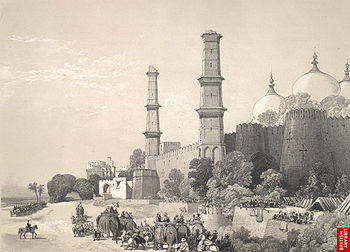 Badshahi Mosque with damaged minarets during Sikh rule
Badshahi Mosque with damaged minarets during Sikh rule
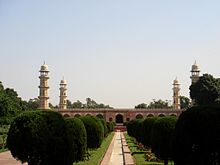 Mughal Emperor Jehangir's mausoleum in Shahdara, Lahore
Mughal Emperor Jehangir's mausoleum in Shahdara, Lahore
Ranjit Singh was crowned on 12 April 1801 at Lahore. The 1740s were years of chaos, and the city had nine different governors between 1745 and 1756. Invasions and chaos in local government allowed bands of warring Sikhs to gain control in some areas. In 1799, all Sikh Misls (warring bands) joined into one to form a sovereign Sikh state ruled by Maharaja Ranjit Singh from the royal capital, Lahore. During the 1740s, frequent invasions by Afghans led by Ahmad Shah Abdali and chaos in local government had made life very uncomfortable for the citizens of Lahore. Bhangi Misl was the fist Sikh band to invade and plunder the Mughal Lahore. Later Ranjit Singh was able to make gains in this chaos. He defeated the grandson of Abdali, Zaman Shah in a battle between Lahore and Amritsar. Out of the chaos of Afghani and Sikh conflicts emerged a victorious Sikh by the name of Ranjit Singh who was able to unify the Sikh factions and capture Lahore where he was crowned Emperor.
On 7 July 1799, the Sikh militia of the Sukerchakia chief, Ranjit Singh, occupied of Lahore.[21] For that brief half century, from 1799 to 1846, Lahore recovered under the patronage of Ranjit Singh and his successors. Ranjit Singh consolidated the Sikh misls who had ruled more or less independently during the eighteenth century under a unified command and in 1799 he established Lahore as the administrative capital of a new Sikh kingdom. Nearby Amritsar became the spiritual and commercial center of the kingdom in 1802, after Ranjit Singh's troops occupied the city and the maharaja announced his intention to extend patronage and protection to the city's leading groups.
While much of Lahore's Mughal era fabric lay in ruins by the end of eighteenth century, rebuilding efforts under the Sikhs were focused on the Sikh community as many visitors to the city noted that much of the city was in disrepair and many of its Mauseleums and Mosques were pillaged and desecrated; in many instances components were pillaged from ancient structures to build Sikh temples and houses. The grand Badshahi mosque was used as a horse stable and the minaret used as targets by the Sikh artillery regiments. Much of the city's Muslim inhabitants suffered considerably during this time and the period is generally associated with the descretion of much of Lahore's ancient architectural wonders.
Ranjit Singh death in 27 June 1839 ultimately ended his reign, while his son Dalip Singh became his successor. He was buried in Lahore and his samadhi still stands there.
British Raj
Main article: British RajMaharajah Ranjit Singh made Lahore his capital and was able to expand the kingdom to the Khyber Pass and also included Jammu and Kashmir, while keeping the British from expanding across the River Sutlej for more than 40 years.
After his death in 1839 the internecine fighting between the Sikhs and several rapid forfeitures of territory by his sons, along with the intrigues of the Dogras and two Anglo-Sikh wars, eventually led to British control of the Lahore Darbar ten years later. For the British, Punjab was a frontier province, because Lahore had boundaries with Afghanistan and Persia. Therefore, the Punjabis, unlike the Bengalis and the Sindhis, were not allowed to use their mother tongue as an official language. The British first introduced Urdu as an official language in Punjab,[22][23] including Lahore, allegedly due to a fear of Punjabi nationalism.
Arrival of the British Colonial Rule
Main article: British RajThe British occupation of Lahore took place in a protracted but concerted manner. Capitalizing on the disarray surrounding the succession struggles after Ranjit Singh's death and only partially diminished by a war fought against the Sikhs on their eastern frontier, the British rode into Lahore in February 1846 and garrisoned their troops in the citadel. Two unstable years later, they were drawn into a second war with the Sikhs at the southern city of Multan when that city's governor, Mul Raj, encouraged his troops to rebel. After a series of closely fought battles, the Sikh army was finally defeated in the Battle of Gujrat, sixty miles north of Lahore. In March 1848, following the British victory, Dalip Singh, Ranjit Singh's teenage son and heir to the throne, was formally deposed in Lahore. The remaining Sikh regiments in the city were abruptly decommissioned and camped outside the city demanding severance pay. Within a year, the Punjab was formally annexed to the British Empire and military sappers had begun leveling Lahore's city wall.
British rule
Under British rule (1849–1947), colonial architecture in Lahore combined Mughal, Gothic and Victorian styles. The General Post Office (GPO) and YMCA buildings in Lahore commemorated the golden jubilee of Queen Victoria, an event marked by the construction of clock towers and monuments all over India. Other important British buildings included the High Court, the Government College University, the museums, the National College of Arts, Montgomery Hall, Tollinton Market, the University of the Punjab (Old Campus) and the Provincial Assembly.[24] Under British rule, Sir Ganga Ram (sometimes referred to as the father of modern Lahore) designed and built the General Post Office, Lahore Museum, Aitchison College, Mayo School of Arts (now the NCA), Ganga Ram Hospital, Lady Mclagan Girls High School, the chemistry department of the Government College University, the Albert Victor wing of Mayo Hospital, Sir Ganga Ram High School (now Lahore College for Women) the Hailey College of Commerce, Ravi Road House for the Disabled, the Ganga Ram Trust Building on Shahrah-e-Quaid-e-Azam, and the Lady Maynard Industrial School.[25] He also constructed Model Town, a suburb that has recently developed into a cultural center for Lahore's growing socioeconomic elite.
The city has built a new campus in quieter environments on the Canal Bank, but the old university buildings are still functioning. For the sake of entertainment, the British introduced horse-racing to Lahore. The first racing club, established in 1924, is called LRC or Lahore Race Club.
Role in Independence
Further information: Pakistan Movement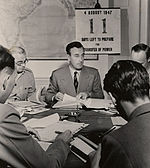 Viceroy Lord Mountbatten of Burma with a countdown calendar to the Transfer of Power in the background.
Viceroy Lord Mountbatten of Burma with a countdown calendar to the Transfer of Power in the background.
 Chaudhry Khaliquzzaman seconding the Lahore Resolution with Muhammad Ali Jinnah presiding the Lahore session
Chaudhry Khaliquzzaman seconding the Lahore Resolution with Muhammad Ali Jinnah presiding the Lahore session
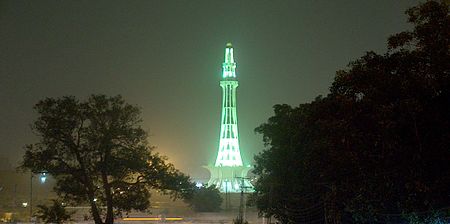 Minar-e-Pakistan, where the Pakistan Resolution was passed
Minar-e-Pakistan, where the Pakistan Resolution was passed
Lahore enjoys a special position in the history of Pakistan Movement and Indian Independence Movement. The 1929 Congress session was held at Lahore. In this Congress, a resolution of "complete independence" was moved by Pandit Nehru and passed unanimously at midnight on 31 December 1929.[26] On this occasion, the contemporary tricolour of India (with a chakra at its centre) was hoisted as a national flag, and thousands of people saluted it.
Lahore prison was a place to detain revolutionary freedom fighters. Noted freedom fighter Jatin Das died in Lahore prison after fasting for 63 days in protest of British treatment of political prisoners. One of the martyrs in the struggle for Indian independence, Shaheed Sardar Bhagat Singh, was hanged in Lahore Jail.[27]
The most important session of the All India Muslim League, later the Pakistan Muslim League, the premier party fighting for Indian independence and the creation of Pakistan, was held in Lahore in 1940.[28] Muslims under the leadership of Quaid-e-Azam demanded a separate homeland for Muslims of India in a document known as the Pakistan Resolution or the Lahore Resolution. During this session, Muhammad Ali Jinnah, leader of the league, publicly proposed the Two Nation Theory for the first time.
Post-independence till present
Lahore is regarded as the heart of Pakistan and is now the capital of the Punjab province in the state of Pakistan. Almost immediately after the independence, large scale riots broke out among Muslims, Sikhs and Hindus, causing many deaths as well as damage to historic monuments—including the Lahore Fort, Badshahi Mosque and other colonial buildings.[29] With United Nations assistance, the government was able to rebuild Lahore, and most scars of the communal violence of independence were erased. Less than 20 years later, however, Lahore once again became a battleground in the War of 1965. The battlefield and trenches can still be observed today close to the Wagah border area.
After independence, Lahore lost much of its glory to Karachi, which quickly became the biggest and most industrialised city. It was not until the administration of Mian brothers, and the 1990s riots in Karachi that Lahore once again gained its significance as an economic and cultural powerhouse through government reforms. The second Islamic Summit Conference was held in the city.[30] In 1996 the International Cricket Council Cricket World Cup final match was held at the Gaddafi Stadium in Lahore.
The Walled City of Lahore known locally as the "Un-droone Shehr" (Inner City) is the oldest and most historic part of Lahore. The Punjab government embarked on a major project in 2009 to restore the Royal Trail (Shahi Guzar Gah) from Akbari Gate to the Lahore Fort with the help of the World Bank under the Sustainable Development of the Walled City of Lahore (SDWCL) project. The project aims at the Walled City development, at exploring and highlighting economic potential of the Walled City as a cultural heritage, exploring and highlighting the benefits of the SWDCL project for the residents, and at soliciting suggestions regarding maintenance of development and conservation of the Walled City.
The present day Lahore is a three-in-one city. That is why, when one visits Lahore; he finds three different cities - each distinguished from other in one way or other. The old city - existed for at least a thousand years - developed in and around circular road. Similarly, the British built Lahore covers the area from Mayo Hospital to the Canal Bank on the east. Unquestionably, third Lahore which includes various posh localities such as Gulberg, Bahria Town, Defence Housing Authority along with several others developed after the independence.[31]
References
- ^ Amin, Mohamed; Willets, Duncan; Farrow, Brendan (1988). Lahore. Lahore, Punjab, Pakistan: Ferozsons, Ltd.. p. 20. ISBN 969-0-00694-0.
- ^ Imperial Gazetteer of India, v. 16, p. 106
- ^ HUDUD AL-'ALAM 'The Regions of the World' A Persian Geography[dead link]
- ^ Dawn Pakistan - The 'shroud' over Lahore's antiquity
- ^ Temple wrought with stories by Haroon Khalid
- ^ An evaluation of Lahore Style of Architecture
- ^ Muslim Rajputs
- ^ unknown (1793). [http://books.google.com.pk/books?id=gt_QAAAAMAAJ&pg=PA152&lpg=PA152&dq=Jeipal+raja+lahore&source=bl&ots=rIOts3tOGP&sig=i4jgsytt7gO-1dEwz2lvCTmbwRE&hl=en&ei=M7uwTMPUIIfRcd-srbAN&sa=X&oi=book_result&ct=result&resnum=3&ved=0CBgQ6AEwAg#v=onepage&q=Jeipal%20raja%20lahore&f=false The British critic , Volumes 1-2]. p. 152. http://books.google.com.pk/books?id=gt_QAAAAMAAJ&pg=PA152&lpg=PA152&dq=Jeipal+raja+lahore&source=bl&ots=rIOts3tOGP&sig=i4jgsytt7gO-1dEwz2lvCTmbwRE&hl=en&ei=M7uwTMPUIIfRcd-srbAN&sa=X&oi=book_result&ct=result&resnum=3&ved=0CBgQ6AEwAg#v=onepage&q=Jeipal%20raja%20lahore&f=false.
- ^ Muḥammad Qāsim Hindū Shāh Astarābādī Firishtah (1829). History of the rise of the Mahomedan power in India: till the year A.D. 1612. p. 9. http://books.google.com.pk/books?id=PbzNyrr2QyMC&pg=PR23&lpg=PR23&dq=Jeipal+raja+lahore&source=bl&ots=yBUNDzDhPL&sig=c-wveik83oKm4tg155yORukA9MI&hl=en&ei=M7uwTMPUIIfRcd-srbAN&sa=X&oi=book_result&ct=result&resnum=2&ved=0CBYQ6AEwAQ#v=onepage&q=Jeipal%20raja%20lahore&f=false.
- ^ History of Lahore, Lahore City Government. Retrieved on September 19, 2007.[dead link]
- ^ India The early Turkish sultans
- ^ South Asia By Christopher V. Hill page 63 http://books.google.co.uk/books?id=f9D4Ob1YcJgC&pg=PA63&lpg=PA63&dq=lahore+mughal+empre&source=bl&ots=ZfiGpBNcOA&sig=hZoQS7N7bgolJPFbhpC_BYwYku0&hl=en&ei=kAV_SrawLdXajQfoiezwAQ&sa=X&oi=book_result&ct=result&resnum=5#v=onepage&q=&f=false
- ^ a b GC University Lahore
- ^ For a detailed account of the battle fought, see Chapter VI of The Fall of the Moghul Empire of Hindustan by H.G. Keene.[dead link]
- ^ Encyclopædia Britannica article on Lahore
- ^ Nalwa, V. (2009), Hari Singh Nalwa - Champion of Khalsaji, New Delhi: Manohar, p. 10, ISBN 81-7304-785-5.
- ^ Grewal, J. S. (1990). "Chapter 6: The Sikh empire (1799–1849)". The Sikh empire (1799–1849). The New Cambridge History of India. The Sikhs of the Punjab. Cambridge University Press. http://histories.cambridge.org/extract?id=chol9780521268844_CHOL9780521268844A008.
- ^ Encyclopædia Britannica Eleventh Edition, (Edition: Volume V22, Date: 1910-1911), Page 892.
- ^ The Ninth Master Guru Tegh Bahadur (1621-1675)
- ^ a b J. S. Grewal (1998). The Sikhs of the Punjab. Cambridge University Press. p. 79. ISBN 0521637643. http://books.google.com/?id=2_nryFANsoYC&pg=PA79&lpg=PA79&dq=%22Aurangzeb%22%2B%22Wazir+Khan%22.
- ^ http://www.thesikhencyclopedia.com/pakistan/lahore.html
- ^ Maybin, Janet. Language and literacy in social practice. Open University. p. 102.
- ^ Coulmas, Florian. Writing systems. p. 232.
- ^ Famous Architecture at lahoredishaan.com
- ^ Gill, Anjum. "Father of modern Lahore remembered on anniversary." Daily Times (Pakistan). July 12, 2004.
- ^ Tribune India - Republic Day
- ^ Daily Times Pakistan - Memorial will be built to Bhagat Singh, says governor
- ^ Story of Pakistan - Lahore Resolution 1940, Jin Technologies. Retrieved on September 19, 2007.
- ^ Dalrymple, William. Lahore: Blood on the Tracks.
- ^ Second Islamic Summit Conference
- ^ Lahore - Paris of the East
Lahore topics History Origins • Etymology • Hindu rule • Muhammadan period • Mughal rule • Sikh rule • British rule • Lahore Resolution • 1965 War • Lahore DeclarationGeography Economy Stock market • Water supply and sanitation • Transport • Health care • Education • Tallest buildings • Sister citiesCulture Architecture • Cinema • Cuisine • Festivals • Language • Music • People • Religion • Shopping • SportsPlaces Categories:- History of Lahore
- Lahore
- Pre-Islamic heritage of Pakistan
Wikimedia Foundation. 2010.



